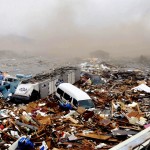Japan's Quake: Assessing the Damage
 The tsunami and earthquake that hit Japan appear to have done enormous damage, but many factors may have helped limit the final death toll.
The tsunami and earthquake that hit Japan appear to have done enormous damage, but many factors may have helped limit the final death toll.
There's a lot that remains unknown about the tsunami and earthquake that appears to have done enormous damage in Japan. Three things that I'd keep in mind:
1.) The video footage so far indicates that this may not be a huge loss of life: The most stunning and widely circulated footage has shown tsunami waters flowing over an airport.
This may actually be a good thing. Airports are the largest areas of flat land in almost all urbanized areas. They'll produce dramatic tsunami footage but aren't actually likely to be that terribly damaged by the flood waters.
2.) The main area the tsunami struck is not really a city at all. Kurihara, Miyagi is actually a metropolitan government that oversees ten more-or-less distinct small towns. In any case, the population density of about 140 people per square mile is quite low. By comparison, New York City has 26,000 people per square mile, Fairfax County, Virginia about 1,000m and Maricopa County, Arizona--bigger than New Jersey and home to Phoenix and enormous areas of unbuilt desert--still has 341 people per square mile. In short, it's basically a rural area. This means that the death toll is likely to be reasonably low although rescue may take a very long time.
3.) Japan's politically powerful construction industry, if nothing else, manages to build a lot. The nation's spending on construction has actually accelerated even as its economy as swooned. Japan also requires seismic retrofitting of almost everything. None of the reports I have seen so far include any major building collapses which, usually, are the causes of most human deaths in earthquakes.
A real tragedy has struck Japan but, most likely, the loss of life and real damage will be reasonably limited.
Tweet